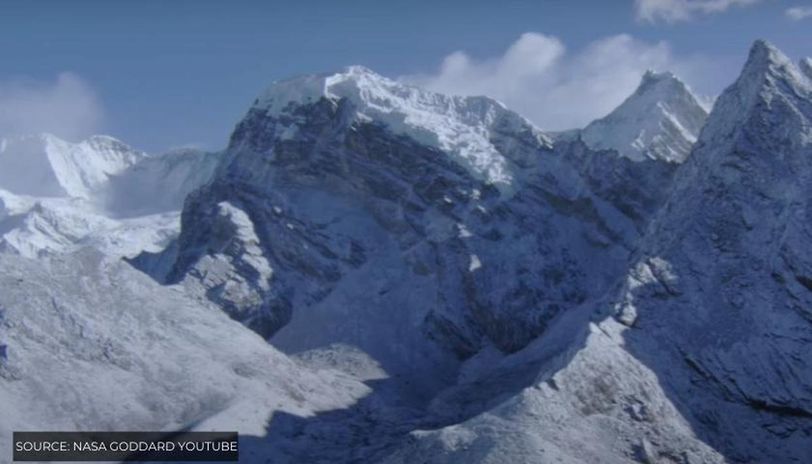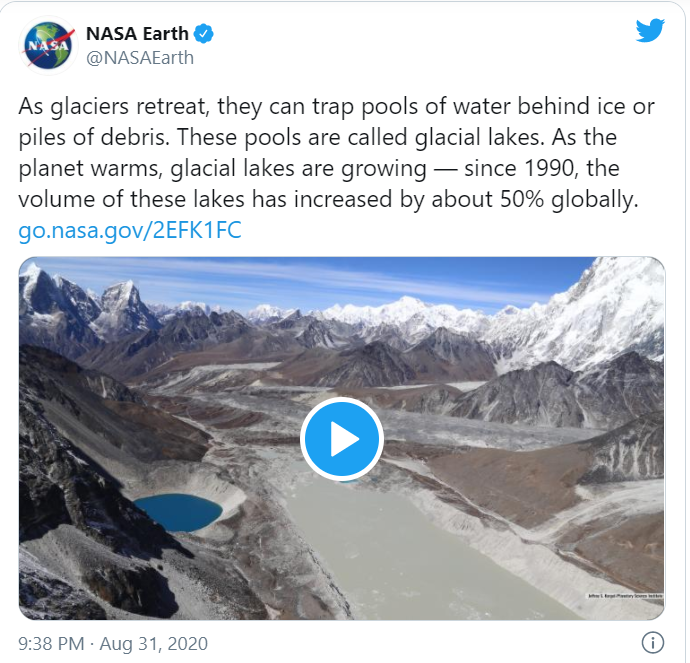NASA’s study on global warming show an alarming rise in Glacial Lakes across continents with a rise in 50% of lake volume across continents.

Researchers with the help of National Aeronautics and Space Administration’s satellite data have monitored an alarming increase in the size of glacial lakes across the globe. The study was conducted along an adventure trail to trace some of the highest mountain tops for example- Mt Everest, alongside the ‘third pole’ of the earth that is the Himalayan Range. However, the traces and the mountain trails are rapidly changing as reported in the study published in Nature climatic Change journal.
NASA’s study on global warming
As per NASA’s recent post, the study has been undertaken since the 1990s and until now, the volume of glacial lakes have increased by almost 50% of its original size. As per the study, this major change is the result of retreating glaciers caused by temperature change in the cryosphere. In the last 30 years, the researchers have monitored the range changes across the Himalayan ranges which showed glacier’s melted water settle in the lakes, later transported to the ocean.
However, in transportation, the increased glacial water, moraine and the residue will only act as a life-threatening situation to the habitat and communities living downstream. The lakes are unstable and the potential hazards are highlighted in the global warming study. Despite the study focused on the Himalayas, the glacier change is a global phenomenon, as per the study.
NASA’s tweet regarding the study-

As per the official statements provided in the press release shared by NASA, dated August 31, the changes are quite rampant, the release further established that “We have known that not all meltwater is making it into the oceans immediately,” as per author Dan Shugar of the University of Calgary in Canada. “But until now there were no data to estimate how much was being stored in lakes or groundwater.” The study estimates current glacial lake volumes total about 37.4 cubic miles (156 cubic kilometres) of water, the equivalent of about one-third the volume of Lake Erie.
Shugar and his collaborators from governments and universities in Canada, the United States, and the United Kingdom, working under a grant from NASA’s High Mountain Asia Program, initially planned to use satellite imaging and other remote-sensing data to study two dozen glacial lakes in High Mountain Asia, the geographic region that includes the Tibetan Plateau and surrounding mountain ranges, including the Himalaya. “We wrote scripts in Google Earth Engine, an online platform for very large analyses of geospatial data, to look only at High Mountain Asia, and then decided to look at all glacial lakes in the world,” Shugar said. “From there, we were able to build a scaling relationship to estimate the volume of the world’s glacial lakes based on the area of this large population of lakes.”
Climate change analysed with glaciers melting as the key focus
The team ultimately analyzed more than 250,000 scenes from the Landsat satellite missions, a joint NASA/U.S. Geological Survey program. A decade ago, it would not have been possible to process and analyze this volume of data. The team looked at the data in five time-steps beginning with 1990 to examine all the glaciated regions of the world except Antarctica and analyze how glacial lakes changed over that period.
Shugar points out that while water from glaciers melting stored in glacial lakes is a relatively small contributor to overall sea-level rise, it can have a major impact on mountain communities downstream of these glacial lakes.“This is an issue for many parts of the world where people live downstream from these hazardous lakes, mostly in the Andes and in places like Bhutan and Nepal, where these floods can be devastating,” Shugar said. “Fortunately, organizations like the United Nations are facilitating a lot of monitoring and some mitigation work where they’re lowering the lakes to try and decrease the risks.”
Article Credit: republicworld
